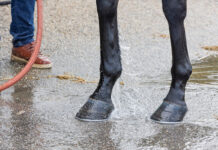In our Ask the Vet column, Dr. Lydia Gray answers your horse-health questions at horseillustrated.com/AskTheVet. Got a question for Dr. Gray? Send it to hc-editor@luminamedia.com and use subject line “Ask the Vet.”
Q: I recently bought a Thoroughbred mare that is seriously underweight. I’m worried that she might have ulcers. I’ve had her for a few weeks on grain and 24/7 hay and she doesn’t seem to be gaining any weight. How can you tell if she has ulcers? If she doesn’t, what can I do to bring her weight up?
A: The best way to tell if a horse has gastric ulcers is to have a veterinarian scope the stomach and look. Because not every practice has the necessary equipment though, sometimes it’s okay to just start a horse on the FDA-approved prescription medication GastroGard and see if there’s any improvement. Of course, your veterinarian should perform a complete physical examination on your mare first to make sure that that there aren’t additional medical reasons for her to have trouble gaining weight, such as parasites, infection, or other causes.
Getting back to gastric ulcers, clinical signs can include weight loss and poor body condition, as well as a dull hair coat, decreased appetite and performance, mild or recurrent colic, and a poor attitude (girthiness, irritability, resistance, etc). Because the risk factors for gastric ulcers are some of the same things that can cause ANY horse to be underweight, I’ve listed them out along with suggestions for eliminating or reducing their impact on your horse:
Stress (caused by training, competition, shipping, injury, etc)
Simply moving a horse from one environment to another, which includes separating her from her herd buddies, can be enough stress to trigger gastric ulcers or weight loss. Try to establish a regular schedule at the new barn – with set feeding time, stall time, turnout time, exercise time, and the all-important social time – that relieves any anxiety she may have.
Infrequent feeding/Limited access to hay and pasture
Because horses were intended to be “trickle feeders,” acid is released into the stomach nearly continuously (as opposed to humans who only produce stomach acid when stimulated by a meal). It sounds like you already understand how important it is to keep forage in front of your horse, so my advice here is to feed high quality grass hay from a small hole hay net and add a flake of alfalfa at meal times. And if you are able to provide pasture grazing time, fresh grass would be ideal!
Large grain meals
Researchers have found that feeding more than ½ percent of a horse’s bodyweight in grain at one time can lead to gastric ulcers (that’s 5 pounds for a 1000 pound horse). Since you are feeding grain, make sure she’s not getting large meals of it but that you’re splitting it up into 3 or 4 or more feedings throughout the day.
Once you’ve had your veterinarian look her over and reviewed these risk factors for where you might be able to make positive changes, consider things that could be added to her diet to improve her body condition score. One at a time (so you know what works and what doesn’t), experiment with beet pulp, hay cubes or pellets, rice bran, pure fat, digestive support (probiotics, prebiotics, yeast, and/or enzymes) and other goodies. Between working with your vet to ensure she’s healthy and keeping tasty feedstuffs in front of her, I’m confident your new mare will begin to blossom soon!








